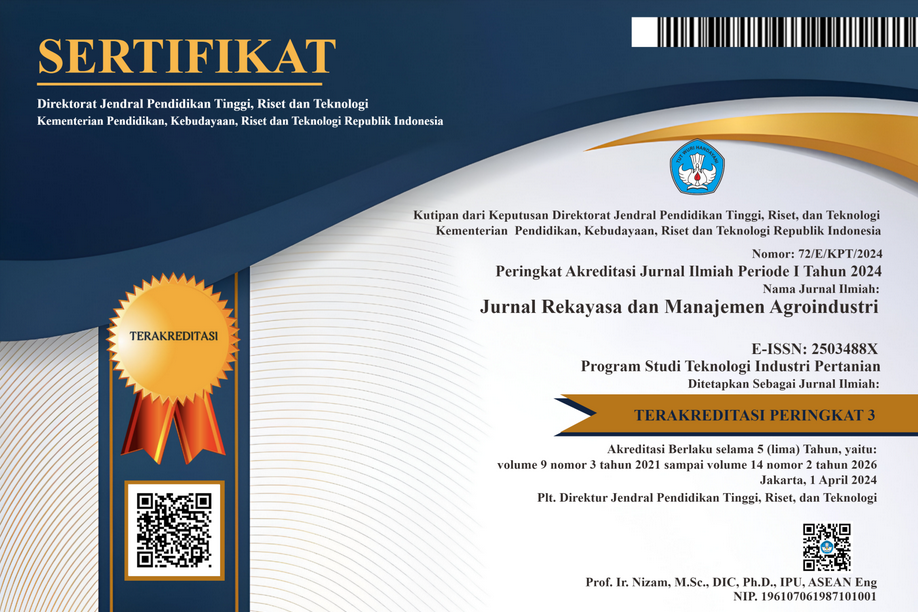Karakteristik Komposit Biotermoplastik Dari Pati Termoplastik/Glukomanan Termoplastik/Poliasam Laktat Dalam Variasi Jenis Dan Konsentrasi Compatibilizer
Abstract
ABSTRACT
Biotermoplastic is a one of the innovation to improve the physical and mechanical properties of bioplastics. This study aims to determine the effect of the type and concentration of compatibilizer on the characteristics of biothermoplastic composites and to determine the type and concentration of the right compatibilizer to produce the best characteristics of biothermoplastic composites of thermoplastic starch/thermoplastic glucomannan/polylactic acid (TPS/TPG/PLA). This research utilizes a Completely Randomized Design (CRD) with 6 treatments, namely J1KI (maleic acid anhydride 5%), J1K2 (maleic acid anhydride 7,5%), J1K2 (maleic acid anhydride 10%), J2K1 (stearic acid 5%), J2K2 (stearic acid 7,5%), and J2K3 (stearic acid 10%), with 3 replications. The variables observed in this study were tensile strength, elongation at break, elasticity, swelling, density, melting point and biodegradation time. The data were analyzed by analysis of variance (ANOVA) and further tested using the Honestly Significant Difference (HSD) test. The results showed that the type and concentration of compatibilizer had a very significant effect on the values ??of tensile strength, elongation at break, elasticity, swelling, density, melting point and biodegradation time. The best characteristics of biothermoplastic composites of thermoplastic starch/thermoplastic glucomannan/polylactic acid were obtained by using 10% anhydrous maleic acid compatibilizer with a tensile strength value of 30.43 MPa, an elongation at break of 0.90%, elasticity of 3.38 GPa, swelling of 0.51%, density of 1.52 g/cm3, melting point of 149.77oC and biodegradation time of 17.667 days.
Keywords: Biothermoplastic composites, compatibilizer, thermoplastic glucomannan, thermoplastic starch, polylactic acid
ABSTRAK
Biotermoplastik adalah salah satu ivovasi yang dilakukan untuk meningkatkan dan memperbaiki sifat fisik dan mekanik dari bioplastik. Penelitian ini bertujuan mengetahui pengaruh jenis dan konsentrasi compatibilizer terhadap karakteristik komposit biotermoplastik serta menentukan jenis dan konsentrasi compatibilizer yang tepat untuk menghasilkan karakteristik terbaik dari komposit biotermoplastik pati termoplastik/glukomanan termoplastik/poliasam laktat (TPS/TPG/PLA). Penelitian ini menggunakan Rancangan Acak Lengkap (RAL) dengan 6 perlakuan yaitu J1KI (asam maleat anhidrat 5%), J1K2 (asam maleat anhidrat 7,5%), J1K2 (asam maleat anhidrat 10%), J2K1 (asam stearat 5%), J2K2 (asam stearat 7,5%) dan J2K3 (asam stearat 10%) dengan 3 kali ulangan. Variabel yang diamati pada penelitian ini meliputi kuat tarik, perpanjangan saat putus, elastisitas, pengembangan tebal, densitas, titik leleh dan waktu biodegradasi. Data dianalisis sidik ragam (ANOVA) dan diuji lanjut menggunakan Uji Beda Nyata Jujur (BNJ). Hasil penelitian menunjukan bahwa jenis dan konsentrasi compatibilizer berpengaruh sangat nyata terhadap nilai kuat tarik, perpanjangan saat putus, elastisitas, pengembangan tebal, densitas, titik leleh dan waktu biodegradasi. Karakteristik terbaik dari komposit biotermoplastik pati termoplastik/glukomanan termoplastik/poliasam laktat diperoleh dengan menggunakan compatibilizer asam maleat anhidrat 10% dengan nilai kuat tarik 30,43 MPa, nilai perpanjangan saat putus 0,90%, elastisitas 3,38 GPa, pengembangan tebal 0,51%, densitas 1,52 g/cm3, titik leleh 149,77oC dan waktu biodegradasi 17,667 hari.
Kata kunci : komposit biotermoplastik, kompatibilizer, glukomanan termoplastik, pati termoplastik, poliasam laktat.
Downloads
References
Albar, A., Rahmaniah, dan Ihsan. 2021. Pembuatan dan Karakterisasi Bioplastik Berbahan Dasar Pati Umbi Uwi Ungu, Plastisizer Gliserol dan Kitosan. Jurnal Teknosains, 15(3), 253–257.
Britanica, T. E. of E. 2024. Young,s Modulus. Encyclopedia Britannica. https://www.britannica.com/science/Youngs-modulus
Clasen, S. H., Müller, C. M. O., dan Pires, A. T. N. 2015. Maleic Anhydride As a Compatibilizer and Plasticizer In TPS/PLA Blends. Journal of the Brazilian Chemical Society, 26(8), 1583–1590. https://doi.org/10.5935/0103-5053.20150126
Darni, Y., Sitorus, T. M., dan Hanif, M. 2014. Produksi Bioplastik dari Sorgum dan Selulosa Secara Termoplastik. Jurnal Rekayasa Kimia & Lingkungan, 10(2), 55-62. https://doi.org/10.23955/rkl.v10i2.2420
Dominguez-Candela, I., Gomez-Caturla, J., Cardona, S. C., Lora-García, J., and Fombuena, V. 2022. Novel Compatibilizers and Plasticizers Developed from Epoxidized and Maleinized Chia Oil in Composites Based on PLA and Chia Seed Flour. European Polymer Journal, 173, 1-14. https://doi.org/10.1016/j.eurpolymj.2022.111289
Fibriyani, D. 2017. Pengolahan Onggok Singkong Sebagai Plastik Biodegradable Menggunakan Plasticizer Gliserin dari Minyak Jelantah. Jurnal Aplikasi Teknologi Pangan, 6(2), 74-77. https://doi.org/10.17728/jatp.195
Harsojuwono, B. A., Arnata, I. W., dan Hartiati, A. 2023. Pengembangan Pellet Biotermoplastik Berbasis Pati Singkong Termodifikasi dan Glukomanan (Studi Jenis dan Konsentrasi Polimer Sintetis). Laporan Penelitian. Fakultas Teknologi Pertanian, Universitas Udayana.
Harsojuwono, B. A., Arnata, I. W., Hartiati, A., Setiyo, Y., Hatiningsih, S., and Suriati, L. 2022. The Improvement of the Modified Starch—Glucomannan—Polyvinyl Alcohol Biothermoplastic Composite Characteristics With Polycaprolactone and Anhydride Maleic Acid. Frontiers in Sustainable Food Systems, 6. https://doi.org/10.3389/fsufs.2022.844485
Hartatik, Y. D., Nuriyah Lailatin, dan Iswarin. 2014. Pengaruh Komposisi Kitosan terhadap Sifat Mekanik dan Biodegradable Bioplastik. Brawijaya Physics Student Journal, 2(1).
Jeziorska, R., Szadkowska, A., Spasowka, E., Lukomska, A., and Chmielarek, M. 2018. Characteristics of Biodegradable Polylactide/Thermoplastic Starch/Nanosilica Composites: Effects of Plasticizer and Nanosilica Functionality. Advances in Materials Science and Engineering, 2018 (4571386), 1–15.
Nur, R. A., Nazir, N., dan Taib, G. 2020. Karakteristik Bioplastik dari Pati Biji Durian dan Pati Singkong yang Menggunakan Bahan Pengisi MCC (Microcrystalline Cellulose) dari Kulit Kakao. Gema Agro, 25(1), 1–10. https://doi.org/http://dx.doi.org/10.22225/ga.25.1.1713.01-10
Nurhajati, D. W., dan Indrajati, I. N. 2011. Kualitas Komposit Serbuk Sabut Kelapa Dengan Matrik Sampah Styrofoam pada Berbagai Jenis Compatibilizer. Jurnal Riset Industri, 5(2), 143–151.
Pamela, V. Y., Syarief, R., Savitri Iriani, E., dan Edhi Suyatma, N. 2016. Karakteristik Mekanik, Termal dan Morfologi Film Polivinil Alkohol dengan Penambahan Nanopartikel ZnO dan Asam Stearat untuk Kemasan Multilayer. Jurnal Penelitian Pascapanen Pertanian, 13(2), 63–73.
Saputra, M. R. B. S., dan Supriyo, E. 2020. Pembuatan Plastik Biodegradable Menggunakan Pati Dengan Penambahan Katalis Zno Dan Stabilizer Gliserol. Pentana: Jurnal Penelitian Terapan Kimia, 1(1), 41–51. https://ejournal2.undip.ac.id/index.php/pentana/article/view/11598
Saputro, A. N. C., dan Ovita, A. L. 2017. Sintesis Dan Karakterisasi Bioplastik dari Kitosan-Pati Ganyong (Canna Edulis). JKPK (Jurnal Kimia Dan Pendidikan Kimia), 2(1), 13-21. https://doi.org/10.20961/jkpk.v2i1.8526
Sudirman, K., A. K., Gunawan, I., Handayani, A., dan Evi Hertinvyana, dan. 2002. Sintesis dan Karakterisasi Komposit Polipropilena/Serbuk Kayu Gergaji. In Jurnal Sains Materi Indonesia Indonesian Journal of Materials Science, 4(1), 20-25.
Elastomer Insitut Ritchter. 2024. Tensile Strength, Tear Resistance And Elongation At Break. https://elastomer-institut.de/en/
Torres, F. G., Arroyo, O. H., and Gomez, C. 2007. Processing and Mechanical Properties of Natural Fiber Reinforced Thermoplastic Starch Biocomposites. Journal of Thermoplastic Composite Materials, 20(2), 207–223. https://doi.org/10.1177/0892705707073945
Waryat, Romli, M., Suryani, A., Yulianingsih, I., dan Johan, S. 2013. Penggunaan Compatibilizer Untuk Meningkatkan Karakteristik Morfologi, Fisik Dan Mekanik Plastik Biodegradabel Berbahan Baku Pati Termoplastik Polietilen. Jurnal Sains Materi Indonesia, 14(3), 214–221.
Waryat, Romli, M., Suryani, A., Yuliasih, I., dan Nasiri, S. J. A. 2013. Karakteristik Mekanik, Permeabilitas Dan Biodegrabilitas Plastik Biodegradable Berbahan Baku Komposit Pati Termoplastik-LLDPE. Jurnal Teknologi Industri Pertanian, 23(2), 153–163.
Yuniari, A. 2012. Sifat Mekanik Dan Morfologi Termoplastik Elastomer (TPE) Hasil Polipaduan NBR/PVC Dan Maleat Anhidrat. Ajalah Kulit, Karet, Dan Plastik, 28(1), 18–25.

Ciptaan disebarluaskan di bawah Lisensi Creative Commons Atribusi-BerbagiSerupa 4.0 Internasional.
Seluruh artikel di Jurnal ini dapat disebarluaskan atas tetap mencantumkan sumber yang syah. Identitas judul artikel tidak boleh dihilangkan. Penerbit tidak bertangggung jawab terhadap naskah yang dipublikasikan. Isi artikel menjadi tanggung jawab Penulis.














